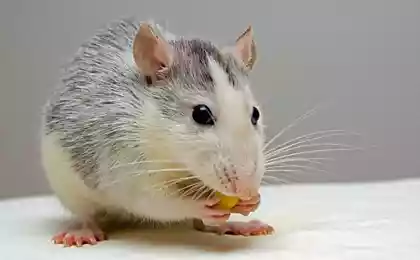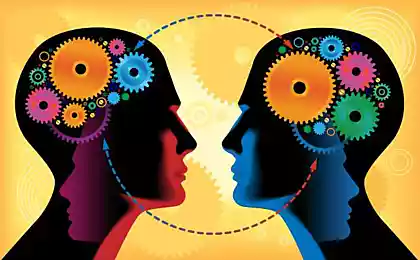362
Logical mistakes made by scientists
"Purity" of the experimentFalse analogy, confirmation bias, confirmation error by the consequence – not only ordinary mortals, but also experienced scientists can fall into these logical traps.
One Norwegian scientist decided to study the logical errors made by his colleagues, scientists who find out the mechanisms of cognitive behavior. Our Norwegian whistleblower is called Espen SobergHe works in the Department of Behavioral Sciences at the University College of Oslo and Akershus. His very interesting research tells us how much a person is likely to fall into a logical trap. And the higher the stakes, the more serious the possible mistakes.
It does not matter if we make a mistake in solving the problem of the Cretan liars. But when mistakes in the logic of reasoning are made by scientists studying cognitive function and mental disorders, the consequences can be most serious – for example, the whole human picture of the world will be wrong.

In his work, Soberg studied the mistakes made in studies using model organisms. You’ve probably heard of experiments involving laboratory mice, chimpanzees, frogs and fruit flies. These are some of the most widely known model animals, but along with them you can mention chickens, and squid, and cats (if we are talking about the animal world), and rice, and corn and onions (if we are talking about the plant world), and salmonella, and E. coli (if we are talking about bacteria).
They are called model because they are used as models to study the properties, phenomena and processes of living nature.
For example, it is convenient to put genetic experiments on flies-drozophylls - their rapid reproduction allows you to quickly draw conclusions about hereditary changes, study the genotype and phenotype.
As for man, he is not a model organism in the broad sense. However, when it comes to neurophysiological research, we have a big advantage over other living things.Thanks to the ability to introspection, a person can talk about his feelings, and therefore can be both an object and a subject of research.
But with the help of mice and rats, a whole range of mental diseases is studied - anxiety, attention deficit hyperactivity disorder (ADHD), autism, depression, schizophrenia.
A little logic: confirmation by the investigationNow let’s remember what logical errors are. These are conclusions based on incorrect logical reasoning. Errors creep into reasoning either when the argument is incorrect or when objects that are not identical with those about which the conclusion is made are the subject of the proof.
One common logical error is confirmation of the consequent or confirmation by the investigation. Look at this statement:
1. If A is true, then B is true.
2. B right.
3. Therefore, A is true.
At first glance, it is difficult to find a mistake here, but we will try to substitute meaningful premises and conclusions in place of the letters:
1. If it's warm today, I'll go swimming.
2. I'm going swimming.
3. So it's warm today.
1. If the Bible is true, Jerusalem is a city.
2. Jerusalem is a real city.
3. That's why the Bible is true.
You may have come across people who use similar arguments. You may have thought so yourself without thinking that your conclusion is illogical. This reasoning is called confirmation of the consequence. This logical error consists in the fact that the truth of the effect of a statement is used to confirm the truth of the statement itself.
All to prove the hypothesis
The error of confirmation by the investigation is associated with the unconscious desire of a person who seeks to prove something, to find confirmation of his hypothesis. Many scientists undertake experiments, assuming that their experimental paradigm is a legitimate extension of the hypothesis. Naturally, in such conditions, the results are used to confirm already existing beliefs.
For example, we have this hypothesis: patients with bipolar disorder have reduced cognitive abilities. In testing, we measure the speed of their reactions. We may fall into the wrong line of reasoning: “If people with bipolar disorder have a reduced rate of cognitive processes, then in the course of the experience they will show delayed reactions. We see slower reactions, therefore, people with bipolar disorder have a reduced rate of cognitive processes.”
However, we cannot say with certainty that this is indeed the case. The result, of course, suggests such a possibility, but patients may have shown slower reactions for a variety of reasons. And until we have assembled the evidence base that points to a connection between the inference and the hypothesis, and considered all the reasons that could cause them to react more slowly, it is impossible to say with certainty that the hypothesis was confirmed.
Karl Popper argued that hypotheses cannot be confirmed, but only falsified: we cannot conclude with absolute certainty that a statement is true, but we can conclude that it is false. A classic example is the “white swan hypothesis”: even if we only observed white swans, we cannot say with certainty that “all swans are white.” But if we see at least one black swan, we can recognize this statement as untrue.

There are studies on how people perceive the behavior of infants of different sexes. Some participants were told that the crying baby was a boy and others that it was a girl. Most of the first group perceived the reaction of the “boy” as anger, and the “girls” as fear (later children, faced with the expectations of adults, themselves begin to interpret their emotions as they are told).
In our search for truth, we must remember that there is always the possibility that a hypothesis is wrong, even if the facts we have today make it unlikely.
Confirmation biasConfirmation bias or confirmation bias is another logical trap that tends to favor information that supports our point of view. It is this information that will first come across in search (because we are looking for it) and attract attention in experiments (because we pay attention to it). The process of fact-finding and interpretation is designed to reinforce existing concepts.
Some researchers suggest that the propensity for confirmation bias varies by field of study, and physicists, biologists, psychologists, and mathematicians are more successful at avoiding this error than historians, sociologists, or engineers, although the data vary greatly from study to study.
Thinking by analogyArmed with the knowledge of logical errors, we return to model organisms. In animal studies, which serve as an example for the study of human diseases, scientists sometimes use an approach known as the “Scientist.” An argument by analogy. This means that the properties of one group are inferred from observations of the second group because both have some other traits in common.
However, the similarity between objects in one thing does not guarantee that they are similar in something else. For example, if Pasha and Sveta are brother and sister, and Pasha is clumsy, we can conclude that Sveta is also clumsy. However, we have no information to claim this. Pasha and Light share genes, but there can be many reasons for clumsiness. And if we think that it is wrong, then it is wrong.
Analogous reasoning is a potentially erroneous judgment based on similarities between entities. However, this kind of reasoning does not make the argument fallible by default. The analogy may or may not be true. The very concept of model animals implies an analogy, since it is based on the assumption that they are similar to the target group of people in some qualities.
If the similarity between two groups (in this case, man and animal) is high enough, then the arguments made by analogy should be considered valid. A false analogy occurs when one group (e.g., animals) has qualities that overlap with those of another group (e.g., humans), and we assume that the two groups also share other characteristics.
It may seem that an animal performs an action that requires complex thinking, but in reality its behavior only resembles manifestations of such thinking. We anthropomorphize animals by humanizing their behavior. Another example is birds that mimic human speech. Humanization is the notion that birds can actually understand our concept of language while they are simply repeating sounds.
How to make research more objective
The human psyche is a complex subject that requires careful verification of research procedures. Even in the case of two human beings, it is sometimes impossible to determine why mental illnesses occur the way they do. What to say about “similar” conditions in animals.
However, Espen Soberg The aim is not to prevent scientists from conducting research on model organisms, but to increase their awareness, which will avoid potential risks and possible misconceptions. Here's what he advises scientists to do to improve research:
Author: Alice Zagradskaya
P.S. And remember, just by changing your consciousness – together we change the world!
Source: //newtonew.com/science/animal-model-research
One Norwegian scientist decided to study the logical errors made by his colleagues, scientists who find out the mechanisms of cognitive behavior. Our Norwegian whistleblower is called Espen SobergHe works in the Department of Behavioral Sciences at the University College of Oslo and Akershus. His very interesting research tells us how much a person is likely to fall into a logical trap. And the higher the stakes, the more serious the possible mistakes.
It does not matter if we make a mistake in solving the problem of the Cretan liars. But when mistakes in the logic of reasoning are made by scientists studying cognitive function and mental disorders, the consequences can be most serious – for example, the whole human picture of the world will be wrong.

In his work, Soberg studied the mistakes made in studies using model organisms. You’ve probably heard of experiments involving laboratory mice, chimpanzees, frogs and fruit flies. These are some of the most widely known model animals, but along with them you can mention chickens, and squid, and cats (if we are talking about the animal world), and rice, and corn and onions (if we are talking about the plant world), and salmonella, and E. coli (if we are talking about bacteria).
They are called model because they are used as models to study the properties, phenomena and processes of living nature.
For example, it is convenient to put genetic experiments on flies-drozophylls - their rapid reproduction allows you to quickly draw conclusions about hereditary changes, study the genotype and phenotype.
As for man, he is not a model organism in the broad sense. However, when it comes to neurophysiological research, we have a big advantage over other living things.Thanks to the ability to introspection, a person can talk about his feelings, and therefore can be both an object and a subject of research.
But with the help of mice and rats, a whole range of mental diseases is studied - anxiety, attention deficit hyperactivity disorder (ADHD), autism, depression, schizophrenia.
A little logic: confirmation by the investigationNow let’s remember what logical errors are. These are conclusions based on incorrect logical reasoning. Errors creep into reasoning either when the argument is incorrect or when objects that are not identical with those about which the conclusion is made are the subject of the proof.
One common logical error is confirmation of the consequent or confirmation by the investigation. Look at this statement:
1. If A is true, then B is true.
2. B right.
3. Therefore, A is true.
At first glance, it is difficult to find a mistake here, but we will try to substitute meaningful premises and conclusions in place of the letters:
1. If it's warm today, I'll go swimming.
2. I'm going swimming.
3. So it's warm today.
1. If the Bible is true, Jerusalem is a city.
2. Jerusalem is a real city.
3. That's why the Bible is true.
You may have come across people who use similar arguments. You may have thought so yourself without thinking that your conclusion is illogical. This reasoning is called confirmation of the consequence. This logical error consists in the fact that the truth of the effect of a statement is used to confirm the truth of the statement itself.
All to prove the hypothesis
The error of confirmation by the investigation is associated with the unconscious desire of a person who seeks to prove something, to find confirmation of his hypothesis. Many scientists undertake experiments, assuming that their experimental paradigm is a legitimate extension of the hypothesis. Naturally, in such conditions, the results are used to confirm already existing beliefs.
For example, we have this hypothesis: patients with bipolar disorder have reduced cognitive abilities. In testing, we measure the speed of their reactions. We may fall into the wrong line of reasoning: “If people with bipolar disorder have a reduced rate of cognitive processes, then in the course of the experience they will show delayed reactions. We see slower reactions, therefore, people with bipolar disorder have a reduced rate of cognitive processes.”
However, we cannot say with certainty that this is indeed the case. The result, of course, suggests such a possibility, but patients may have shown slower reactions for a variety of reasons. And until we have assembled the evidence base that points to a connection between the inference and the hypothesis, and considered all the reasons that could cause them to react more slowly, it is impossible to say with certainty that the hypothesis was confirmed.
Karl Popper argued that hypotheses cannot be confirmed, but only falsified: we cannot conclude with absolute certainty that a statement is true, but we can conclude that it is false. A classic example is the “white swan hypothesis”: even if we only observed white swans, we cannot say with certainty that “all swans are white.” But if we see at least one black swan, we can recognize this statement as untrue.

There are studies on how people perceive the behavior of infants of different sexes. Some participants were told that the crying baby was a boy and others that it was a girl. Most of the first group perceived the reaction of the “boy” as anger, and the “girls” as fear (later children, faced with the expectations of adults, themselves begin to interpret their emotions as they are told).
In our search for truth, we must remember that there is always the possibility that a hypothesis is wrong, even if the facts we have today make it unlikely.
Confirmation biasConfirmation bias or confirmation bias is another logical trap that tends to favor information that supports our point of view. It is this information that will first come across in search (because we are looking for it) and attract attention in experiments (because we pay attention to it). The process of fact-finding and interpretation is designed to reinforce existing concepts.
Some researchers suggest that the propensity for confirmation bias varies by field of study, and physicists, biologists, psychologists, and mathematicians are more successful at avoiding this error than historians, sociologists, or engineers, although the data vary greatly from study to study.
Thinking by analogyArmed with the knowledge of logical errors, we return to model organisms. In animal studies, which serve as an example for the study of human diseases, scientists sometimes use an approach known as the “Scientist.” An argument by analogy. This means that the properties of one group are inferred from observations of the second group because both have some other traits in common.
However, the similarity between objects in one thing does not guarantee that they are similar in something else. For example, if Pasha and Sveta are brother and sister, and Pasha is clumsy, we can conclude that Sveta is also clumsy. However, we have no information to claim this. Pasha and Light share genes, but there can be many reasons for clumsiness. And if we think that it is wrong, then it is wrong.
Analogous reasoning is a potentially erroneous judgment based on similarities between entities. However, this kind of reasoning does not make the argument fallible by default. The analogy may or may not be true. The very concept of model animals implies an analogy, since it is based on the assumption that they are similar to the target group of people in some qualities.
If the similarity between two groups (in this case, man and animal) is high enough, then the arguments made by analogy should be considered valid. A false analogy occurs when one group (e.g., animals) has qualities that overlap with those of another group (e.g., humans), and we assume that the two groups also share other characteristics.
It may seem that an animal performs an action that requires complex thinking, but in reality its behavior only resembles manifestations of such thinking. We anthropomorphize animals by humanizing their behavior. Another example is birds that mimic human speech. Humanization is the notion that birds can actually understand our concept of language while they are simply repeating sounds.
How to make research more objective
The human psyche is a complex subject that requires careful verification of research procedures. Even in the case of two human beings, it is sometimes impossible to determine why mental illnesses occur the way they do. What to say about “similar” conditions in animals.
However, Espen Soberg The aim is not to prevent scientists from conducting research on model organisms, but to increase their awareness, which will avoid potential risks and possible misconceptions. Here's what he advises scientists to do to improve research:
- Be aware of your own limitations.Everyone can be wrong, and researchers are also susceptible to cognitive biases. However, it is difficult to notice them yourself - you will hardly notice that your back is white. Therefore, in the report of the experiment, it makes sense to indicate the factors that can lead to errors.
- Provide predictive and mechanistic validity.Prognostic validity will ensure that the knowledge gained during the test is more likely to apply to people. Mechanistic validity suggests that the mechanisms that cause observable behavior are the same for animals and humans.
- Determine a priori hypotheses and plan of statistical analysis in advance.It is important to have a hypothesis before the experiment, so that there is no temptation to pull the hypothesis and the conclusion to each other after the fact.
- Analyze the statistical power of the study to determine the sample size that the experiment should cover.
- Use double-blind testing. This will help reduce the effect of confirmation error and the effect of the experimenter.
- Avoid humanization.Even if an animal’s external behavior is similar to that of a human, no one can guarantee that the causes of such behavior are similar to those that would cause the same behavior in humans.
- Avoid reasoning by analogy.Even if the study in mice yielded results, we cannot be sure that the observed effect allows us to draw conclusions about people.
- Disclose the result even if it is zero.If you expected to get any result based on the literature on the topic, but could not reproduce this result experimentally, do not refuse to publish the data. By sharing your findings, you will make the research generally more objective.
- Repeat the experiment. This reduces the risk that the initial outcome was accidental. If the replays are successful, try to incorporate the new hypothesis and experimental manipulations into a common problem field to expand our knowledge of the issue. And finally, try to replicate the experiment on humans.
Author: Alice Zagradskaya
P.S. And remember, just by changing your consciousness – together we change the world!
Source: //newtonew.com/science/animal-model-research























